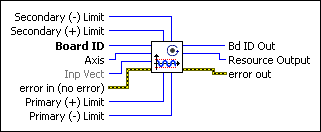Load Torque LimitLoads primary and secondary DAC torque limits for an axis.
| Device Compatibility
|
 |
Secondary (–) Limit
is the optional secondary DAC negative torque (or velocity) limit. The range is –32,768 to +32,767 (–10 V to +10 V) with a default value of –32,768 (–10 V).
|
||||||
 |
Secondary (+) Limit is the optional secondary DAC positive torque (or velocity) limit. The range is –32,768 to + 32,767 (–10 V to +10 V) with a default value of 32,767 (+10 V). | ||||||
 |
Board ID is a unique number assigned by Measurement & Automation Explorer (MAX) used to send and receive commands and data to or from a specific NI motion controller. | ||||||
 |
Axis is the axis to control. | ||||||
 |
Inp Vect contains the primary positive, primary negative, secondary positive, and secondary negative parameters that are the source of data for this VI.
Available input vectors include immediate (0xFF), variable (0x01 through 0x78), or indirect variable (0x81 through 0xF8). Refer to Input and Return Vectors for more detailed information. |
||||||
 |
error in (no error) describes error conditions that occur before this VI runs. The default input of this cluster is no error. If an error already occurred, this VI returns the value of error in in error out. The VI runs normally only if no incoming error exists. Otherwise, the VI passes the error in value to error out. The error in cluster contains the following parameters:
|
||||||
 |
Primary (+) Limit is the primary DAC positive torque (or velocity) limit. The range is –32,768 to + 32,767 (–10 V to +10 V) with a default value of 32,767 (+10 V). | ||||||
 |
Primary (-) Limit
is the primary DAC negative torque (or velocity) limit. The range is –32,768 to + 32,767 (–10 V to +10 V) with a default value of –32,768 (–10 V).
|
||||||
 |
Bd ID Out is provided for flow control. You can string together NI-Motion VIs by wiring the Bd ID Out terminal of one VI to the Board ID terminal of the next VI. | ||||||
 |
Resource Output is the Axis, Vector Space, ADC, or Encoder you wired into the VI. Use Resource Output to pass the resource to another VI and/or to display information about the device. | ||||||
 |
error out contains error information. If error in indicates an error, error out contains the same error information. Otherwise, it describes the error status that this VI produces.
|
Using This VI
The Load Torque Limit VI allows you to limit the output range of the DAC output(s) on the selected servo axis. This VI has no effect on stepper axes or independent DAC outputs that are not mapped to an axis.
By limiting the output range of a DAC, it is possible to control the maximum torque (when connected to a torque block servo amplifier) or velocity (when connected to a velocity block servo amplifier). This VI is also helpful when interfacing to amplifiers that do not support the standard ±10 V command range.
Primary and secondary DACs can have different limits, and the positive and negative limits can be both positive or both negative to limit the DAC output to a unipolar range. The only restriction is that a positive DAC limit cannot be less than the negative DAC limit.
You also can set a torque offset on the primary and secondary DAC outputs. Refer to the Load Torque Offset VI for more information.
Example
Calling the Load Torque Limit VI with the following parameters limits the output ranges of the primary and secondary DACs mapped to the axis, as shown in the following figure:

Primary Positive Limit = 16,383
Primary Negative Limit = –16,384
Secondary Positive Limit = 8,191
Secondary Negative Limit = –32,768
The result of this VI call is to limit the primary DAC to only half its range in either direction, or ±5 V. The secondary DAC can only travel over a quarter of its positive range but has its full negative range.







